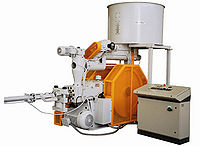Difference between revisions of "Mechanical Briquetting Presses"
Jump to navigation
Jump to search
(Created page with "Category:Particle Formation{{Knoppen}} <noinclude><!------------------------------------------------ * READ THIS FIRST * Only edit this page if you can improve the content. ...") |
PurplePen19 (talk | contribs) |
||
| Line 7: | Line 7: | ||
* Please start editing this page after the /noinclude | * Please start editing this page after the /noinclude | ||
* -------------------------------------------------></noinclude> | * -------------------------------------------------></noinclude> | ||
[[File:Mechanical Briquetting Presses_1.jpg|thumb|200px|right|Mechanical Briquetting Presses]] | |||
'''Mechanical Briquetting Presses''' are suitable for processes that need to produce a high-quality briquette. The mechanical briquetting press develops a compression force of approximately 2000 Kg. Per square centimeter to obtain an high quality briquette having a high specific weight and a remarkably reduced volume, without added adhesives. | |||
The material to be briquetted must be cellulosic and dry (having a moisture content between 10 and 14%). | |||
The hourly production refers to material which, in its original molten state, has a specific weight equal to approximately 160 - 200 Kg/cubic meter | |||
==Common Advantages== | |||
*high reliability and long operational lifetime; | |||
*extremely low maintenance and operating costs; | |||
*high structural quality; | |||
*high compression pressure; | |||
*flexibility to produce round, round with the hole, or square shape briquettes; | |||
*easy integration into current production line; | |||
*significant volume reduction; | |||
*reduction of handling and transportation costs. | |||
==Video== | |||
<youtube>eoSErBSZDNM</youtube> | |||
Latest revision as of 05:53, 5 October 2012
Mechanical Briquetting Presses are suitable for processes that need to produce a high-quality briquette. The mechanical briquetting press develops a compression force of approximately 2000 Kg. Per square centimeter to obtain an high quality briquette having a high specific weight and a remarkably reduced volume, without added adhesives.
The material to be briquetted must be cellulosic and dry (having a moisture content between 10 and 14%).
The hourly production refers to material which, in its original molten state, has a specific weight equal to approximately 160 - 200 Kg/cubic meter
Common Advantages
- high reliability and long operational lifetime;
- extremely low maintenance and operating costs;
- high structural quality;
- high compression pressure;
- flexibility to produce round, round with the hole, or square shape briquettes;
- easy integration into current production line;
- significant volume reduction;
- reduction of handling and transportation costs.
Video
